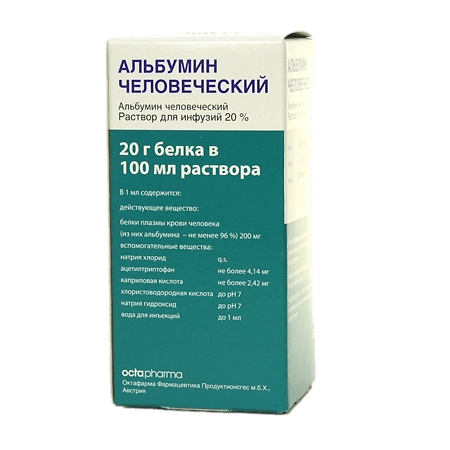No products in the cart.
Human albumin, 20% 100 ml
€1.00
Out of stock
(E-mail when Stock is available)
EAN: 4605992000234
SKU: 211955
Categories: Anesthesia and resuscitation, Anesthesia solutions, Medicine
Description
Quantitatively, human albumin represents more than half of the total plasma protein and accounts for about 10% of the protein-synthesizing activity of the liver.
Human albumin has a hyperoncotic effect. The main physiological functions of albumin are related to its contribution to the regulation of blood oncotic pressure and to its transport function. Albumin is a carrier of hormones, enzymes, drugs and toxinova also normalizes the volume of circulating blood.
Pharmacokinetics
In normal conditions, the total metabolic pool of albumin is 4-5 g/kg body weight, with 40-45% being intravascular and 55-60% in the tissues. In body conditions such as severe burns or septic shock, increased capillary permeability alters albumin kinetics and may cause abnormal distribution. Normally, the average T1/2 albumin is about 19 days. The balance between albumin synthesis and cleavage is usually accomplished through a feedback mechanism. The elimination process is predominantly carried out intracellularly by lysosomal proteases.
In healthy individuals, less than 10% of the injected albumin leaves the intravascular space within the first 2 h. There is considerable individual variability in the effect of albumin infusion on plasma volume. In some patients, plasma volume may remain increased for several hours. However, in patients in critical conditions, albumin may leave the vascular bed in significant amounts and at an unpredictable rate.
Preclinical safety data
Human albumin is a natural component of human plasma and acts similarly to physiological albumin.
The single-dose toxicity study in animals is of little relevance and does not assess toxic or lethal dose or dose-effect relationships.
The study of multiple dose toxicity in animals is not feasible due to the formation of antibodies to the heterogeneous protein.
To date, there are no data regarding embryonic and fetal toxicity, carcinogenic and mutagenic effects of human albumin. Animal studies have also shown no evidence of acute toxicity.
Indications
Indications
Restoration and maintenance of circulating blood volume in case of insufficient volume and appropriateness of colloids, including human albumin may be used in the following clinical conditions:
Active ingredient
Active ingredient
Composition
Composition
Associates:
sodium chloride,
acetyltryptophan,
caprylic acid,
hydrochloric acid,
sodium hydroxide,
d/i water.
How to take, the dosage
How to take, the dosage
The dosage of the administered human Albumin solution is determined individually. When administering Human Albumin, hemodynamic indices and patient’s breathing should be monitored to prevent pulmonary edema. In addition, the patient’s neurological status should be monitored to prevent increase in intracranial pressure.
Human Albumin Solution should be administered intravenously. Human Albumin Solution should not be mixed with other medications, including whole blood and blood components, but it may be used as a concomitant if medically appropriate.
Human Albumin Solution must not be diluted with water for injection as this can cause hemolysis in patients. Human Albumin solution should not be mixed with protein hydrolysates or solutions containing alcohol, since these combinations can lead to precipitation of proteins.
Do not add other medications.
If the dose and rate of administration are not tailored to the solution concentration and clinical status of the patient, administration of Human Albumin may lead to hypervolemia.
In patients receiving Human Albumin, hemodynamic parameters should be monitored to prevent hypervolemia and cardiovascular overload.
Interaction
Interaction
There have been no studies of interactions of Human Albumin with other drugs (unknown due to lack of relevant data in clinical trials, medical literature and safety reports).
Special Instructions
Special Instructions
Allergic reactions/anaphylactic shock
Any suspected allergic or anaphylactic reaction requires immediate discontinuation of the drug. If shock develops, standard antishock therapy should be used.
As this drug is made from human plasma, it may carry the risk of transmission of infectious agents such as viruses and, theoretically, the causative agent of Creutzfeldt-Jakob disease. This also applies to unknown or new viruses and other pathogens.
The risk of pathogen transmission is reduced by screening plasma donors for possible past infection with certain viruses, by testing for current presence of certain viral infections, and by inactivating and/or removing certain viruses. The measures taken are considered effective for enveloped viruses such as HIV, hepatitis B virus, hepatitis C virus, and for nonenveloped viruses such as hepatitis A virus and parvovirus B19. It is highly recommended that the name and series number of the drug be recorded with each administration of Human Albumin to the patient in order to link the patient to the series of the drug.
Hemodynamics
Do not administer without careful monitoring of hemodynamic parameters, monitor for the development of symptoms of heart or respiratory failure, renal failure, or increased intracranial pressure.
Hypervolemia/hemodilution
Human albumin should be used with caution for conditions in which hypervolemia and its consequences or hemodilution may pose a particular risk to the patient. Examples of such conditions are: decompensated heart failure, hypertension, varicose veins, pulmonary edema, hemorrhagic diathesis, severe anemia, renal and postrenal insufficiency. The rate of administration should be adjusted to the concentration of the solution and the hemodynamic parameters of the patient. Rapid infusion may cause circulatory overload and pulmonary edema. At the first clinical signs of cardiovascular overload (headache, dyspnea, jugular vein congestion) or elevated blood pressure, increased central venous pressure and pulmonary edema, the drug administration should be stopped immediately.
Pediatric use
The safety and efficacy of Human Albumin Solution in pediatric patients has not been established, but no additional risks of using the drug in children other than those existing with its use in adults have been identified.
Higher volumes
When replacing relatively large volumes, the clotting system and hematocrit levels should be monitored. It is necessary to ensure adequate replacement of other blood components (clotting factors, electrolytes, platelets and red blood cells). Hemodynamic parameters should be strictly monitored.
Electrolyte status
The patient’s electrolyte status should be monitored during administration of Human Albumin, and appropriate measures should be taken to restore and maintain electrolyte balance.
Blood pressure
Elevated blood pressure after infusion of Human Albumin necessitates close monitoring of the patient after injury or after surgery to detect and treat damaged vessels that may not have bled at lower blood pressures.
Human Albumin Solution should not be mixed with other medications, including whole blood and blood components, but it may be used as a concomitant agent if medically appropriate.
Do not use if the solution is cloudy or the vial is not sealed properly. Preparations for parenteral administration should be visually inspected for mechanical inclusions and discoloration before use, if the solution and container allow for this. If leaks are detected, the drug should be discarded.
There is a risk of hemolysis with potentially fatal consequences and a risk of acute renal failure when sterile water for injection is used to dilute human albumin with a concentration of 20% or higher. Recommended solvents include 0.9% sodium chloride solution or 5% dextrose solution in water.
Influence on driving and operating machinery
There are no data on the effect of Human Albumin on the ability to drive and operate other machines and mechanisms.
Contraindications
Contraindications
Human Albumin solutions must not be diluted with water for injection as this can cause hemolysis in recipients. There is a risk of potentially fatal hemolysis and risk of acute renal failure due to the unacceptable use of sterile water for injection to dilute Human Albumin.
Human Albumin should be used with caution for conditions in which hypervolemia and its consequences or hemodilution may pose a particular risk to the patient. Examples of such conditions are: decompensated heart failure, hypertension, varicose veins, pulmonary edema, hemorrhagic diathesis, severe anemia, and renal and postrenal insufficiency.
Application in renal dysfunction
Human Albumin should be used with caution in conditions in which hypervolemia and its consequences or hemodilution may pose a particular risk to the patient. Examples of such conditions are renal and postrenal insufficiency.
Side effects
Side effects
Adverse Adverse Reactions reported in Clinical Trials
There are no reports of adverse adverse reactions in controlled clinical studies of Human Albumin.
Adverse adverse reactions reported in the post-marketing period
The following adverse adverse reactions have been reported in the post-marketing period. These reactions are listed by class of organ system (SOC) using the preferred Medical Dictionary for Regulatory Affairs (MedDRA) terms in descending order of severity:
Immune system side: anaphylactic shock, anaphylactic reactions, hypersensitivity/allergic reactions.
CNS side: headache.
Cardiovascular system disorders: if it is necessary to use the drug during lactation, the question of stopping breastfeeding should be decided; tachycardia, decreased blood pressure, hot flashes.
Respiratory system disorders: dyspnea.
Digestive system disorders: vomiting, nausea, dysgeusia.
Skin disorders: urticaria, rash, itching.
Local reactions: fever, chills.
Overdose
Overdose
Significant overdosing and increased rate of administration can lead to hypervolemia.
Pregnancy use
Pregnancy use
There are no data on the use of Human Albumin in pregnant women and during lactation. Before prescribing the drug in each individual case, physicians should carefully evaluate the potential risks and benefits of using Human Albumin.
Periatric use
The safety and efficacy of Human Albumin Solution in pediatric patients has not been established, but no additional risks of the drug in children have been identified beyond those associated with its use in adults.
Additional information
| Shelf life | 3 years. Do not use after the expiration date printed on the package |
|---|---|
| Conditions of storage | Store the drug at temperatures from 2° to 25°C. Do not freeze. Keep out of reach of children |
| Manufacturer | Octapharma AG, Austria |
| Medication form | solution for infusion |
| Brand | Octapharma AG |
Related products
Buy Human albumin, 20% 100 ml with delivery to USA, UK, Europe and over 120 other countries.



